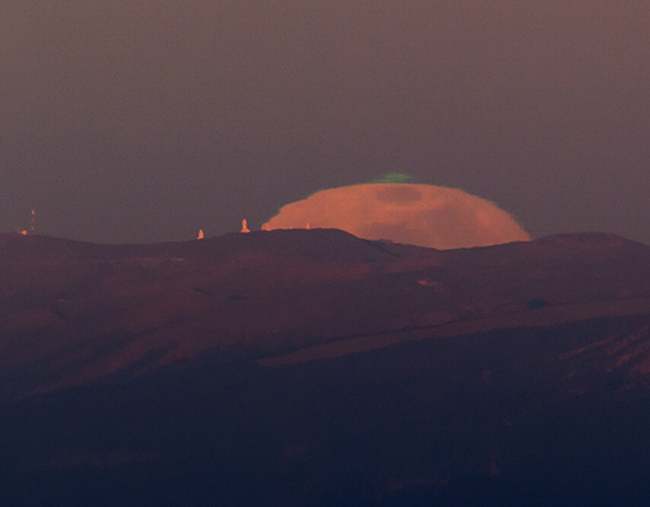That notwithstanding, I am sure that if you ask the question "what colour is the Sun" to the average Joe, you will get an equal share of "white" and "yellow", and maybe some "red" answers. Besides, who among us has never painted a red Sun in a blue sky as a child ?
Physics allows us to explain that when the Sun's light enters our atmosphere, a number of things happen to it. First of all, some of it gets scattered at random angles by the interaction of the photons which constitute the light flux with air molecules. As the probability that a photon interacts this way is highest for light of higher frequency, the photons which undergo scattering are mostly the ones at the blue end of the sun's colour spectrum. These scattered photons eventually reach us from all directions, making the sky appear blue. The phenomenon is called Rayleigh scattering, and from it one of the first determinations of Avogadro's number were obtained over a century ago. But I am divagating...
So what becomes of the unscattered photons ? As they reach your eye, together they still make the Sun appear white, unless it is low on the horizon. (By the way, *NEVER* watch the Sun directly. It will cause permanent damage to your retinas, even if you are wearing dark glasses). When our star is low, its light has to traverse a much longer path through the Earth's atmosphere, and much more of its blue and ultraviolet component is removed. Consequently, the low-frequency part of the spectrum starts to dominate, and you get yellow, then orange, and then red sunsets.
Sunsets, and sunrises, can be a wonderful natural shows, but under certain special conditions they can become even more special. As the Sun's disk starts to disappear beyond the horizon, a different optical effect may set in. The atmosphere is a refractive mean and it can act as a lens, deviating the light by a small angle which depends on the frequency of the light. The highest-frequency light, which for a setting Sun is mostly green, as the blue component has been removed, is now green. And for a short instant, a green flash can be observed before the Sun disappears at the horizon: it is a curved ray of light straying away from the straight path. To see the corresponding phenomenon at sunrise you have to know very well where to look, but the physics is the same.
So, what I have described above is called "green flash", and the ray of deflected light is called "green ray". It is rare, but not extremely so; I once saw it, for a brief instant, watching the sun set over the Adriatic sea while returning on a ship to Venice from Greece.
What I did not know until today was that the same effect can be produced by the light coming to us from the Moon. This light has a slightly different frequency spectrum, reflecting the silver colour of our satellite; what is really different is the intensity of the light source - the full Moon shines at few millionths of the Sun's brightness. These differences, however, do not prevent the same optical effects to take place, if we judge by the incredible picture taken at the Canary islands a few days ago by Daniel Lopez (the picture is taken from the Astronomy Picture of the Day site at http://apod.nasa.gov/apod/astropix.html).

If you look closely, you will see that there is not just a single green ray on top of the disk: there are other smaller rays circling the whole visible circumference. Amazing, is it not ? But of course, wikipedia knew about it all along - the relevant text says: "A green flash also may be observed in association with the Moon and bright planets at the horizon, including Venus and Jupiter."




Comments